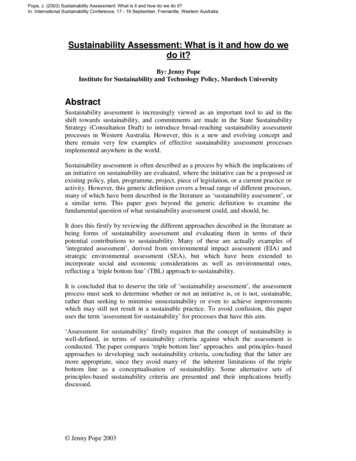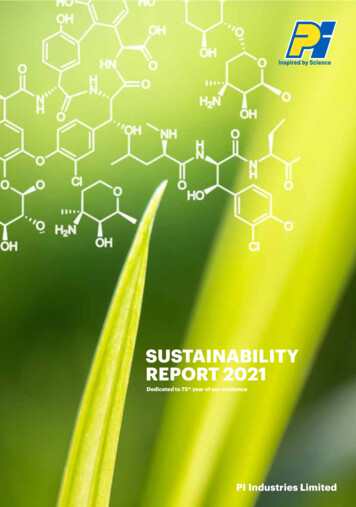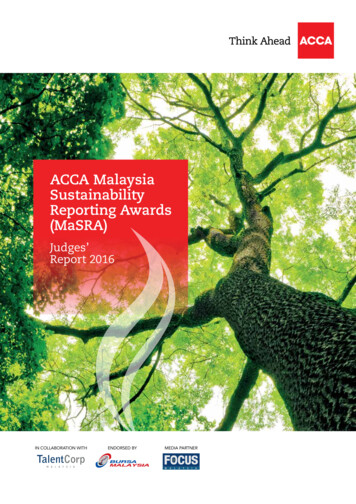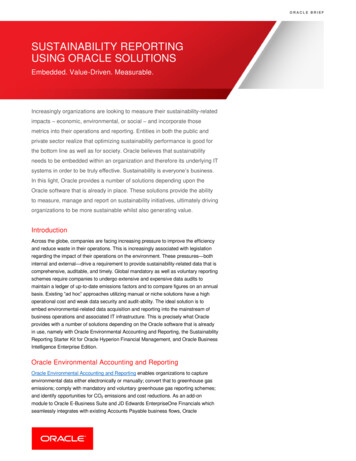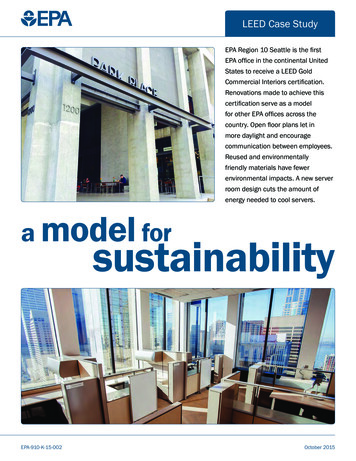
Transcription
LEED Case StudyEPA Region 10 Seattle is the firstEPA office in the continental UnitedStates to receive a LEED GoldCommercial Interiors certification.Renovations made to achieve thiscertification serve as a modelfor other EPA offices across thecountry. Open floor plans let inmore daylight and encouragecommunication between employees.Reused and environmentallyfriendly materials have fewerenvironmental impacts. A new serverroom design cuts the amount ofenergy needed to cool servers.a model forsustainabilityEPA-910-K-15-0021October 2015
At a GlanceBuilding Name: Park PlaceLocation: Downtown Seattle, WAPrimary Tenant: United StatesEnvironmental ProtectionAgency, Region 10 OfficeProject Consultants:Commissioning Agent:Transwestern SustainabilityServicesArchitects: Gensler andMetropolitan Architectsand PlannersConstruction Management:GSA Northwest/Arctic Region,Jacobs, and SustainableDesign Consulting, LLCPrimary Use: Office spaceBuilding Owner: WashingtonPark Place LLCEPA Occupants: 682 employeesProtecting Health and the EnvironmentEPA undertook a project to make its building a more sustainable facility,reducing the environmental impacts of operations while providing a healthyoffice setting that encourages high performance. New floor plans, products,and practices reduce the building’s energy, water, and materials use, andsupport EPA’s mission to protect human health and the environment.In 2009, the Park Place Building received LEED Platinum, the highestpossible certification for existing buildings from the U.S. Green BuildingCouncil. In 2014, the building received a LEED Platinum rating for ExistingBuildings: Operations and Maintenance. In 2015, the EPA Region 10 Seattleoffice received a LEED Gold rating for Commercial Interiors. As a result,EPA Region 10 now occupies three LEED-certified buildings in Seattle,Washington; Lacey, Washington; and Boise, Idaho.Employee ContributionsEPA employees provided input into the design of the space at several allstaff meetings. They also voted on the final floor finishes for their programoffices. Employee volunteers participated on various Move Action Teams,such as the Space Allocation and Standards Team, Furniture Team, and theHealth and Safety Team.Employees contributed artwork. An employee photo contest for the newoffice space resulted in more than 500 submissions; 100 were selected tohang in the new space. Several photos were also selected for wayfindinggraphics.Below: EPA Administrator Gina McCarthy addresses the Region 10 SeattleOffice in May 2014. The conference room features collapsible wallsfor flexible space configuration, shown in more detail on page 7.EPA Net Square Footage:155,407 Sq. Ft.Building Awards:LEED Platinum: ExistingBuildings (2009)LEED Platinum ExistingBuildings: Operation andManagement (2014)LEED Gold: CommercialInteriors (2015)ENERGY STAR Rating: 852
LEED Case StudyBefore moving into the renovated space, employees began recycling oldmaterials to divert waste from the landfill, including 51,255 pounds of paper,3,035 pounds of techno-trash, and 541 pounds of metal, plastics, and glass.Almost 42,000 pounds of office supplies were reused and 934 pounds ofpersonal items were donated to charities. Only 12,518 pounds of trash —12% of the total — were sent to a landfill.Letting Nature Do the WorkA New Server/Network RoomThe 13th floor houses EPA’s servers. They operate 24 hours a day, generatinglarge quantities of heat while consuming considerable energy. In the oldspace, the servers were cooled with costly air conditioning units to preventoverheating and located on the interior core of the floor. The network/serverroom is now located along the building’s perimeter. A new cooling systemtakes air from the outside and filters it into the server/network room ratherthan using conditioned air. This new design, which takes advantage of thePacific Northwest’s mild climate, saves energy by letting nature do the work.EPA compared current HVAC energy consumption from May 29 to June 15,2015 with energy consumption during the same period in 2008, 2009, and2010. Over the course of the 10-year lease, the new system is expected to cutenergy use to cool the server/network room by 47%, saving at least 915,782kWh and approximately 89,747 (using 9.8 cents per kWh for Seattle, WA).Seeing the success in the Seattle office, other regional EPA office buildingswith similar climates, such as EPA’s San Francisco office, are now using thistechnology.Walking the Talk“The path to LEED certificationhas required much research aswell as out-of-the-box thinking.Because we took this path, wefound ways to reduce our impact onthe environment that we might nothave otherwise. It is a tremendousachievement, and one that hasalready helped inform other EPAoffices seeking to become moresustainable. This important work ishelping demonstrate that EPA is truly‘walking the talk’ of conservationand sustainability in our workplaces.I am very proud of what we haveaccomplished.”Dennis McLerranRegional AdministratorEPA Region 10Above: The new cooling system takes airfrom the outside and filters it into theserver/network room at much lower costthan the previous air conditioning units.Left: By using outside air to cool thenetwork/server room, EPA’s new coolingsystem uses less energy than thetraditional cooling system it replaced.3
Open Floor PlansThe redesign for the floor plans includes more open space among the officesto make maximum use of natural daylight rather than relying on electriclights. Enclosed offices are primarily located on the interior core of eachfloor, allowing more daylight to reach open workstations. Workspace cubiclesare furnished with glass panels and located near the windows. The revisedlayout provides greater exposure to daylight for the majority of employees.Studies have shown that natural light helps maintain good health, reducesstress levels, and increases productivity. (U.S. DOE, A Literature Reviewof the Effects of Natural Lights on Building Occupants, 2002.) With theseopen floor plans, employees are also more accessible to each other, whichencourages a team-oriented, high-performance work environment.High-Functioning WorkplaceBelow: Work surfaces can be quicklylowered or elevated, allowing employeesto sit or stand while working.Employee workstations are equipped with work surfaces that can belowered or elevated, which gives employees the option to sit or stand whilethey work. The work surfaces, in combination with ergonomic chairs andadjustable-height monitors, make the workspace comfortable and helpemployees avoid work-related injuries. Other products, including LED tasklights and occupancy monitor strips designed to turn off energy consumptionwhen space is unoccupied, make the workspace more effective and energyefficient.4
LEED Case StudyWater EfficiencyLow-flow water fixtures and faucet aerators have cut the Seattle office’s waterconsumption by 22%. EPA also purchased Water Restoration Certificates tooffset two years’ worth of the Seattle office’s water use, further reducing ourenvironmental footprint. By purchasing certificates, EPA is contributing torestoration of the Middle Deschutes River in Oregon, protecting habitats,and conserving water for crops.Sustainability Begins with ReuseMaking New with the OldThe renovated library on the first floor is one of the biggest reuseaccomplishments of the renovation. Seventy-five percent of the furniture,fixtures, and equipment installed in the new EPA library was reused, includingall the original stacks, carrels, and seating. Seating was reupholstered withenvironmentally-friendly fabric certified by GreenGuard, which measuresemissions and human health factors.Water RestorationCertificatesEPA Region 10 purchased aWater Restoration Certificate fromthe Bonneville EnvironmentalFoundation in 2014. The purchasefunds projects in the Bonneville areathat restore water flows to areaswhere water has become scarce.The certificate offsets the waterused in building operations for thepast two years, equivalent to morethan 2.2 million gallons of water.To reduce the environmental impact and save money, EPA reused existingoffice equipment when possible. New and replacement equipment is EnergyStar qualified. All light fixtures removed during the renovations werereused in new areas, and also updated to allow for daylight dimming and/ormulti-level lighting. These features, combined with more natural light fromlarge windows and an open floor plan, allow occupants to use the amount ofartificial light they prefer. With these updates to the lighting system, the ParkPlace building meets current Seattle Energy Code, which is one of the mostdemanding in the nation.Above: EPA’s Water Restoration Certificateshelp to protect water quality in the DeschutesRiver, home to the American Dipper Bird.Left: The new EPA library includes mostof the furniture, fixtures, and equipmentfrom the old library. All the original stacks,carrels, and seating were reused.5
Above: The new EPA library includes mostof the furniture, fixtures, and equipmentfrom the old library. All the original stacks,carrels, and seating were reused.Above Right: All light fixtures removedduring the renovations were reused innew areas, and also updated to allowdaylight dimming or multi-level lighting.Lighting – Fixture Reuse & Energy SavingsEPA’s new offices used approximately 1,800 salvaged 2x4 and 2x2 T8fluorescent light fixtures. The building added daylight-dimming ballasts anddaylight controls to at least half of the connected lighting load. A BuildingAutomation System (BAS) automatically shuts off lights after businesshours to help with energy management, and occupancy sensors turn offlights when spaces are unoccupied. EPA’s lighting design meets current Cityof Seattle Energy Code for a Lighting Power Density (LPD) of 1 Watt persquare foot (W/s.f.). The project was designed for a 0.74 W/s.f. LPD. EPAprojects a 25% reduction in annual energy use for lighting.Sustainable MaterialsCarpetingThe carpet tile flooring has 24%recycled content. Also, wall-towall carpeting requires completereplacement when sections areworn out; carpet tiles make it easy toreplace just the areas needed.When reuse was not an option, EPA selected sustainable new furnitureand materials based on the recommendations of third-party environmentalorganizations. All the new furniture meets the GreenGuard certificationstandard, ensuring that fabric was sustainably produced and has low or noemissions of volatile organic compounds (VOCs). EPA sought materialswith Cradle-to-Cradle certification, which attests to a product’s safety tohumans and the environment and its design for future life cycles, as wellas BIFMA-level certification, which attests to the sustainability attributesof commercial furniture. Most of the wood products, including doors andfurniture, were certified by the Forest Stewardship Council, which supportsproducts that originate from well-managed forests. In addition, EPA’s workstations have at least 30% recycled content; its high-density mobile storagesystems have more than 50%.6
LEED Case StudySkyfold WallsIn its new conference area on the 21st floor, EPA installed three collapsiblewalls that are not only great for functionality and space utilization but alsohighly sustainable. The infrastructure is made of 92-95% recycled steeland aluminum. The fabric covering contains 40% recycled content and isGreenGuard Gold certified for low emissions.Above: With collapsible walls in themain conference rooms, spaces canbe easily reconfigured to allow formore or less meeting space.Sustainable SitesThe remodel is located in an existing building in a dense urban area. Thissite has a WALK Score of 99/100, which reflects easy walking distance toamenities such as dining, shopping, parks, schools, and entertainment. Ithas a TRANSIT Score of 100/100 with easy access to multiple bus linesand light rail stations. The commitment to remodel downtown encouragesdevelopment in an urban area with excellent existing amenities andinfrastructure, which protects undeveloped habitats and natural resources.ConclusionEPA’s desire to be as sustainable as possible led Region 10 to undertake thechallenge of applying for a LEED Commercial Interiors certification for itsSeattle offices. The end result is a building that testifies every day to EPA’scommitment to protecting human health and the environment.Functional & FlexibleWorkspace“Only once in a career does theopportunity come around to shapeour workspace in the significant waythat has been done in Region 10. Theproject stands as a model for involvingemployees in a deep and meaningfulway. The efforts undertaken to doso have resulted in the creation ofa functional and flexible workspacethat will meet the needs of Region 10employees for years to come.”Mary Kay VoytillaLease Project Manager7
ContributorsCathy Berlow, Architect, US EPALynn Clark, Remodel ProjectCoordinator, GranteeSusan Conbere, CommunicationsSpecialist, US EPA Region 10Andrew Hendrickson, ConstructionManager, US EPA Region 10Joann Mills, Logistics Manager,US EPA Region 10Stephen Podwojski, SustainabilityIntern, US EPA Region 10Melanie Wood, EMS Coordinator,US EPA Region 10All photos courtesy of Jacobs,except for the following:Image of Building Exterior(Page 1), courtesy of EPAImage of Open Office Layout(page 1), courtesy of Sara EllenImage of Gina McCarthy(page 2), courtesy of Emerald LaijaImage of American Dipper Bird(page 5), courtesy of Nancy PartlowImage of Skyfold Walls(page 7), courtesy of MackenzieBorgogni, interiorTechContactTo learn more about this project,contact Andrew Hendrickson athendrickson.andrew@epa.gov8
hours to help with energy management, and occupancy sensors turn off lights when spaces are unoccupied. EPA's lighting design meets current City of Seattle Energy Code for a Lighting Power Density (LPD) of 1 Watt per square foot (W/s.f.). The project was designed for a 0.74 W/s.f. LPD. EPA projects a 25% reduction in annual energy use for .







